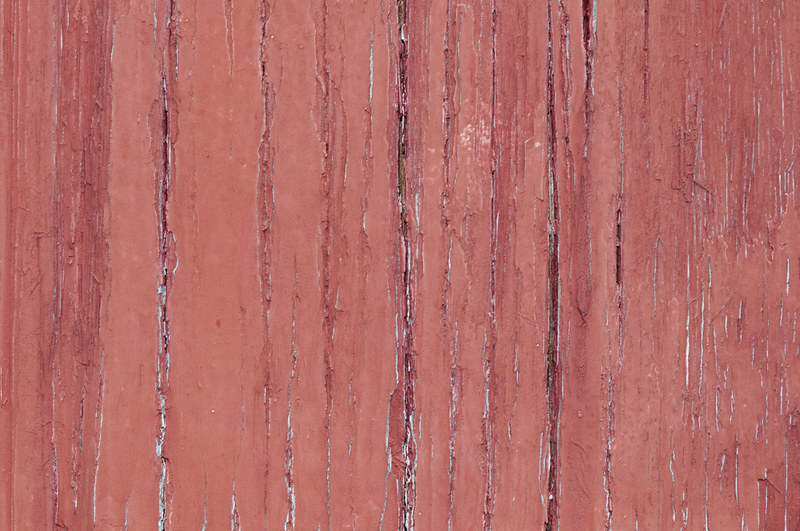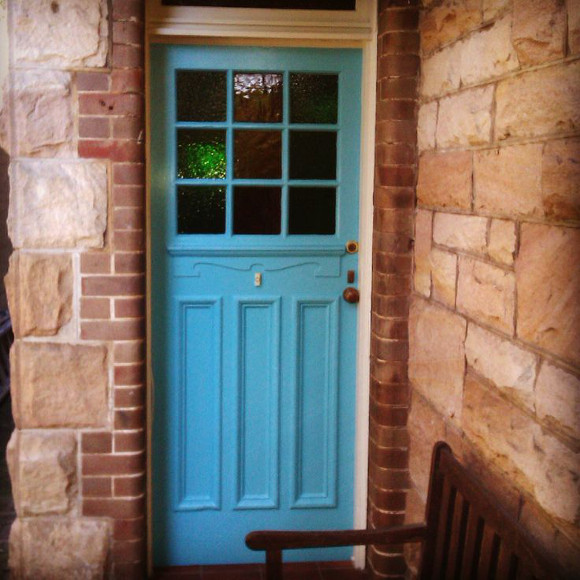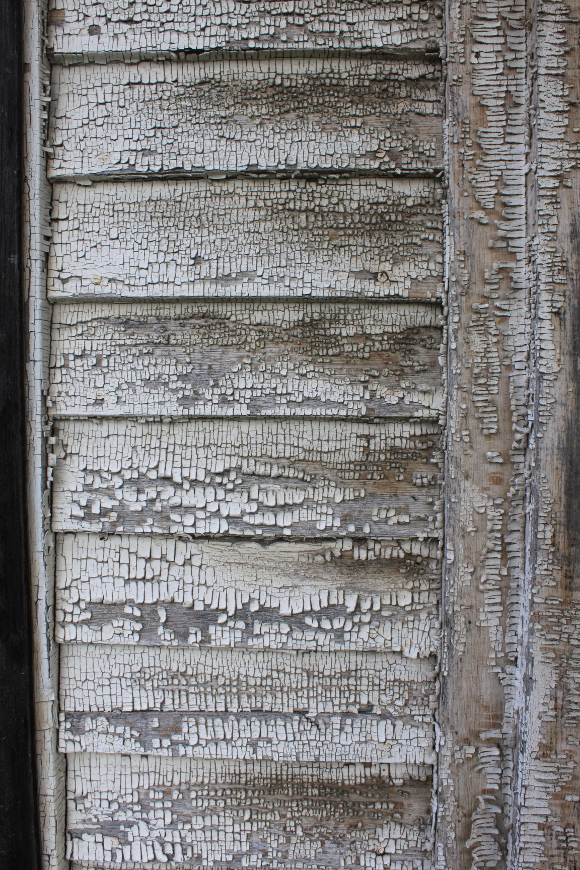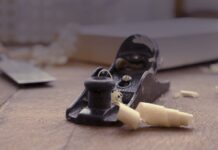So your exterior wood is in a shocking state. Not to worry, it’s perfectly possible to paint it and just as simple to renovate your existing paintwork. You just need to know how. Since we get a lot of questions about the subject, here are our top exterior wood painting tips, including what to do when an existing wood finish needs maintenance.

All about exterior wood paint
First, let’s look at your choices as regards exterior wood paints. These products are expected to survive freezing winters, steaming hot summers, hard rain and UV rays, and they’re tasked with not cracking, fading or peeling. For the best results try to find an all-acrylic formula which will stay flexible, breathable and colour-fast far longer than paints made with traditional vinyl resin or from an acrylic blend. They also stick remarkably fast to stone, vinyl and metal as well as wood.
Exterior wood paint types
How to spruce up your exterior wood? For a start, it depends on the type of paint you’re using. Some water-based wood preservatives can sometimes leave a thin skin on the wood surface, which may eventually peel off in the sun’s heat and leave the wood vulnerable to damp. Spirit-based wood preservatives tend to be the best bet for garden sheds, greenhouses, summerhouses and so on. They soak right into the timber and are very quick and easy to apply. Exterior paints themselves always need at least one coat of quality undercoat, often as many as three if you want to achieve the best possible effect. And preparation is key.
Exterior eggshell paint
Eggshell paint is very hard-wearing and will not wash off walls easily, even outdoors. You can scrub it hard and it remains as tough as old boots. The only thing is it can absorb stains, which are a challenge to remove. Exterior eggshell creates a rugged protective coat that’s incredibly durable. It’s particularly good for wooden front doors, window sills and all outdoor woodwork. You can even use it to paint UPVC – it does a fantastic job and the finish lasts for absolutely ages.
Exterior gloss paint
Exterior gloss paint is durable by nature, formulated to withstand weather. Some exterior glosses come with a 10 year guarantee, testament to their considerable toughness, and in general they last much longer than conventional gloss, flexing and letting moisture escape. Always buy the best quality gloss paint you can afford. Ideally you’ll have prepped the wood first with a suitable quality exterior primer or undercoat.

–>
16 Exterior wood paint tips
Here are our top exterior wood paint tips. Follow this painting guide and you’ll stand a much better chance of getting it right first time and achieving a long-lasting, beautiful result.
- Check the weather forecast first and wait for a decent dry spell
- As a general rule, the better quality exterior paints you buy, the longer they’ll last and the less maintenance you’ll need to do
- Never, ever use interior paints outdoors – the finish will be rubbish and it’ll look terrible in no time
- Preparation is everything. The better you prepare the surface, the longer your finish will last
- It’s no good expending time, money and effort maintaining external paint when the source of the damage hasn’t been dealt with. Tackle any damp, leaks or fungus before you repaint the surface or the finish won’t last
- Avoid painting in the late afternoon if it’s due to be cool and damp overnight. Wait until there’s a warm and dry night on the cards
- Always follow the manufacturer’s instructions
- When painting in very humid, cool or damp weather, allow extra time for the paint to dry completely
- Never paint on damp wood
- Never mix exterior wood paint from different manufacturers – they all have slightly different formulations and rarely mix well
- Remember it’s usually cheaper to buy one big can of outdoor wood paint than several small ones
- Buy good quality primers and undercoats, designed to minimise maintenance. The cheaper you go, the faster the finish will start to degrade
- Always finish the job in one go for an even finish
- Don’t rush it. Take the right amount of care
- Paint close-able windows and doors early in the morning so they dry in time and you can shut them at night
- Start at the top and work downwards, never the other way around
7 Common exterior paint problems
Exterior paints are designed to last a long time, but eventually you’ll encounter problems. Here are some of the most common ones, plus solutions…
- Alligatoring – where the surface looks like lizard skin, all flaky. Remove the old paint completely by scraping or using a heat gun (taking care not to set the surface on fire). Then sand it, prime it and re-paint the surface.
- Blistering – where the surface actually blisters. If the blisters go right down to wood level, it’s important to remove the moisture source before repainting. Then take off the blisters with a scraper and sand the surface smooth, priming bare timber with a high quality primer before adding the top coats.
- Cracking and flaking on multiple coats of paint. You can sometimes get rid of surface cracking by simply removing the loose or flaking paint with a scraper or wire brush, sanding the edges smooth, priming the bare spots and adding your topcoat. If the cracks or flakes go deeper, you’ll need to remove all the paint through sanding, scraping, using a heat gun or all three before priming and repainting.
- Dirt – You can often clean off dirt with a scrubbing brush and soapy water, rinsed with a garden hose. Heavy dirt might require a power washer. Set the pressure at the lowest setting and try a small patch first. If the pressure is too high, it could actually strip the paint from the wood. It’s difficult to get rid of ingrained dirt completely but top quality exterior latex paints are great at repelling it in the first place. And exterior gloss paints are more resistant to dirt pickup than more porous paints.
- Mould – It’s easy to find out whether you’re looking at dirt or mould. Apply a few drops of ordinary household bleach to the discoloured area. If it disappears, it’s likely to be mildew. If it doesn’t, it’s probably just muck. Remove the mildew by scrubbing the surface with a diluted household bleach solution (one part bleach, three parts water), or a dedicated mould and mildew remover. Then rinse it, let it dry, prime the bare wood and add your topcoat.
- Rusty nail stains – Wash the rust off, sand the nail heads down and caulk them with a good water-based all-acrylic caulk. Then spot-prime every nail head separately and paint the surface with a quality latex coating.
- Lost glossiness on gloss paint – Scrape or sand the surface to get rid of the wrinkles in the paint before repainting. Make sure the first coat of paint or primer is perfectly dry before applying the topcoat.

Maintaining wood weatherproofing with wood preservation products
There’s more to exterior finishes than just paints. What about maintaining your wood by weatherproofing with wood preservers? It depends entirely on the previous wood finish or preservation treatment and the manufacturer’s instructions.
Because wood preservers work by sinking into the wood itself, maintenance doesn’t usually involve sanding or scraping them off the surface. It often means simply cleaning the surface first to remove surface dirt and debris. If the surface is particularly grubby, a light sanding may be required before reapplying the product but usually, its simply a case of painting new coats of your chosen product over the top of the old one. Our best tip is this: do exactly what it says on the tin!
Exterior wood paint colours
It helps to think logically about wood paint colour. If the object you’re painting is in an area where there’s a lot of dust or dirt, or it’s particularly exposed to the elements, you might want to choose a colour that won’t show the dirt too much, for example a ‘heritage’ green or grey of some kind, or an especially dark shade. It goes without saying that if you paint your exterior woodwork with white gloss it won’t stay crisp and fresh-looking as a beautiful, trendy shade of grey. The longer-lasting the visual effect, the less frequently you’ll need to carry out exterior wood paint renovation.
Our wood paint
While we focus on wood finishing products, we do sell a carefully selected range of exterior wood paints, including door paints. If you need help choosing the best product for your project, call us for sensible, expert advice.
Need our help with painting exterior wood?
For more information about wood paints and their uses, contact our team of resident experts who are always on hand to help with project advice and product recommendations. Alternatively, see our wood paints FAQ page which covers many of the most commonly asked questions about wood preservers.
We love to see before, during and after photos of any wood finishing project. If you would like to share your project pictures with us and our followers, you can either send us some photos or share on our Facebook, Twitter, Pinterest or Instagram pages.





Hi there,
I’m currently painting an outdoor bar and I’ve done 2 coats of a dark gray. I’ve gone in to touch a few panels and the paint is drying a completely different shade and don’t know why.
It’s the same paint from the same tub, do you have any suggestions of how to fix this ?
Hello,
Touching up with paint or other opaque products can create a variable result, even with the same product used. The original coats have had time to cure and have, even if for a short period, been exposed to the elements. The touch ups are new and uncured and have not had the same exposure as the previously applied coat has. It is possible that over time the patches will start to blend more, however this can be dependant on the time between the original and the new, the colour and the product type.
Some colours will highlight the variance more and how the light reflects on the colour will also have an impact on how prominent the patch appears. White for example and grey, there are many many shades that fall into the grey category and the tiniest change, in application, environment or the product will result in a variation.
I would have to recommend a full application to ensure an all over even result. If you have enough of the paint left to do this then great. If not and you do find you need to get another tin, I would recommend either mixing the two tins together or simply just using the new tin.
Using two different tins, even of the same colour, can result in a variation of finishes again. I hope that helps and please feel free to get in touch via our contact us page if you have any questions at all.
Kind regards Samantha.
We have a dark green gloss painted wooden front door which takes the full force of the summer sun from 2pm. It is prone to blistering. Any suggestions for the best products to avoid this. We have heard aluminium primer and undercoats are good but can you paint over these with exterior gloss to get the final Buckingham green colour?
Good Afternoon Sandy,
Thank you for your patience, I wanted to get some further advice on this one as I am unfamiliar with the Aluminium Primers. Aluminium wood primers are blockers, they are good for sealing knots and things like that. I really don’t think it would help with adhesion.
I think for your project you may find the best option will be to sand back to bare wood and consider an alternative product such as the Sadolin Superdec, we do not supply this one in the desired colour, however if you contact Sadolin they will be able to tell you of a local supplier. This may be the most durable option and one that can give the shine desired.
we have a couple of product that can give a green finish however not the gloss element you want, if you do need and further assistance please do not hesitate to get back in touch via our contact us
page.
Kind Regards Samantha.
Hello
As a general rule of thumb, for both interior but particularly on exterior areas, are oil based paints more durable and is the finish better?
I believe this to be the case from experience but would like a professional opinion.
Many thanks
Hello Peter,
A question we get asked regularly. Oil versus water based, solvent versus water based and there really is no right or wrong answer with this. In the past it was probably fair to say that water based products did not give the same level of durability or protection as the more common solvent /oil based products, and the oil based were the better product to use, all be it a very smell option, sometimes.
Now however water based products have come on leaps and bounds, new formulas and technology has ensured that the water based products can match and in some cases better the more traditional products of the past. Forced by the need to consider user health and the environment, it is likely that water based products are the future of wood finishes. Even Decking Oil can be ‘waterbourne’ these days and actually claims to last longer than the tradition oil based Decking Oils.
So is one better than the other, I would say in 2020, no. They are pretty much on an even keel. When you start to look at individual projects and finishes however there are situations where one will be better than the other and this will be down to individual user and the project itself.
A diplomatic answer I know but at this period of time I believe they are fairly equal.
Kind Regards Samantha.
I am after advice on a full paint system for External and internal faces of old, 130 y/o, wood windows.
I was intending to replace the windows, but on advice have started to strip the worst looking Window to assess the overall condition, and found the timber is in remarkable condition, externally the paint is flakes after 5 years, I intend to fully strip to start over.
I have considered using a preservative coating before any painting to try and future proof the windows.
Your advice would be appreciated.
Good Afternoon John,
For exterior Joinery the Cetol Range from Sikkens is a good option to consider. Once sanded back to bare wood, I would recommend a good wipe over with Barrettine Methylated Spirits to remove any natural oil brought to the surface and then a test area with the product of choice.
For Joinery one coat of the Sikkens Cetol HLS Plus followed by 2 coats of the Sikkens Cetol Filter 7 Plus this will create a medium build surface that can protect for up to 5 years, longer if well maintained.
I would also recommend a preserver before the Cetol is applied and a good option to use with this is the Barrettine Premier Universal a wax free preserver in clear that can be used under paints and stains to help prevent mould and decay.
If you take a look at these, feel free to come back to me with any questions via our contact us page. And always try a test area first.
Kind regards Samantha.
I live on the seafront directly facing the prevailing winds & weather, as well as a south facing frontage that gets the sun nearly all day. I have a high (3 storey) property, with a wide (30cm) wooden fascia board with quite a bit of detail (curves & angles). The wood is in good condition (over 100 years old), but it has to be painted in black gloss paint to comply with the conservation area.
The problem is that whatever we have used – it always starts to flake & fall off after around 2 years. The last time we stripped it back to bear wood, used an aluminium primer & very expensive marine quality (International Yacht paint) base coats & top coats. Its an expensive business, as we need to erect scaffolding to get the height to paint it as well.
I’ve considered using good old car underseal paint to see if that stays on!
Any ideas what we could use on it?
Good Afternoon Clive,
With that much exposure, I suspect whatever you apply will only last so long. You could look at an oil as an alternative, these penetrate the wood and so will not peel and flake over time. They are unlikely to give you the intensity of a paint, but if you use a black preserver first, such as the Barrettine Premier Wood Preserver followed by a black oil such as Osmo Decking Oil this could give a stronger black result, I would strongly recommend a test area first however to ensure good uptake of the products and that you like the result achieved.
I suspect however that these may also wear quite quickly althought they will not peel and flake, like a paint and you are able to apply a fresh coat when needed with out stripping back first.
I hope that is of some help.
Kind regards Samantha.
I have had a wooden verandah errected about 2 years ago and this year it is showing signs of black mould. I need to paint it with something that will last and will not mean i have to clean or paints it every five minutes. Is there any aerosol i could use since it hard work for a hard working lady! Stevie
Hello Stevie,
Thank you for your enquiry. Can you email me with a little more information, such as what type of wood you are treating, does it have any previous treatment applied to it ? And what colour or finish are you looking to achieve ? You can email me at wood@finishes.direct and I will be able to narrow down some suitable products for you.
Kind regards Samantha.
How long can one expect well prepared exterior woodwork to remain in good condition, before starting to crack – as on front door mouldings?
Hello,
In all honesty that is a difficult question to answer because it depends on a number of factors. How much exposure the wood gets to UV, wind, rain, damp and how often it goes from one extreme to the other. What treatment is used and how well it is applied and maintained. So i owuld not like to give you a guess.
Kind regards Sam.
Our timber framed bungalow has been previously painted with Spencer Microflex, which we understand is an oil-based stain. we only want to put one new coat on – do we need to only use an oil-based stain or could we use a water-based stain.
Hello Chris,
Thank you for your inquiry, the general rule is that you need to use Oil based products on top of Oil based and Water based products on top of water based. There are however exceptions and it is very much dependent on each individual product. As I am not familiar with the Spencer Microflex I wouldn’t like to say, a stain product from one range can be very different to a stain product from another. I know that this doesn’t help you much and for that I am sorry but my best advice would be to strip of the previous product and start again. If this is not an option, go with an Oil based product and always try a test area first.